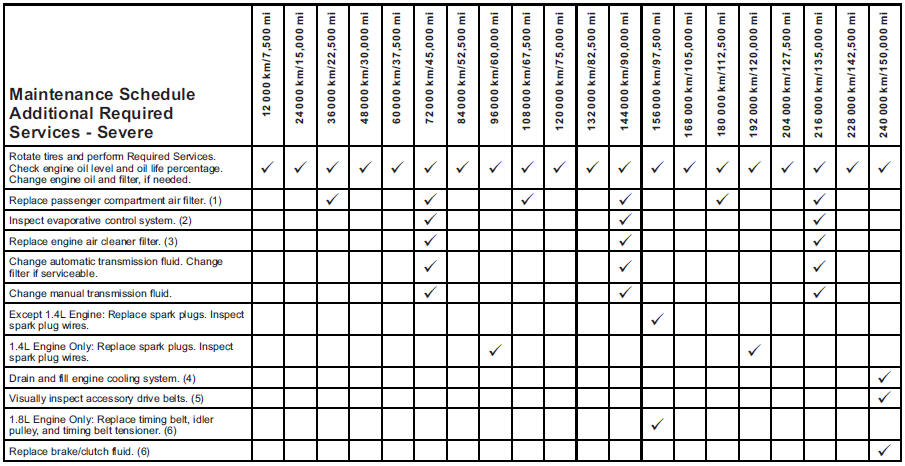Chevrolet Sonic Owner's Manual: Tire Rotation and Required Services Every 12 000 km/ 7,500 mi
Rotate the tires, if recommended for the vehicle, and perform the following services. See Tire Rotation.
- Check engine oil level and oil life percentage. If needed, change engine oil and filter, and reset oil life system. See Engine Oil and Engine Oil Life System.
- Check engine coolant level. See Engine Coolant.
- Check windshield washer fluid level. See Washer Fluid.
- Visually inspect windshield wiper blades for wear, cracking, or contamination. See Exterior Care. Replace worn or damaged wiper blades. See Wiper Blade Replacement.
- Check tire inflation pressures. See Tire Pressure.
- Inspect tire wear. See Tire Inspection.
- Visually check for fluid leaks.
- Inspect engine air cleaner filter. See Engine Air Cleaner/Filter.
- Inspect brake system.
- Visually inspect steering, suspension, and chassis components for damaged, loose, or missing parts or signs of wear. See Exterior Care.
- Check restraint system components. See Safety System Check.
- Visually inspect fuel system for damage or leaks.
- Visually inspect exhaust system and nearby heat shields for loose or damaged parts.
- Lubricate body components. See Exterior Care.
- Check starter switch. See Starter Switch Check.
- Check automatic transmission shift lock control function. See Automatic Transmission Shift Lock Control Function Check.
- Check ignition transmission lock. See Ignition Transmission Lock Check.
- Check parking brake and automatic transmission park mechanism. See Park Brake and P (Park) Mechanism Check.
- Check accelerator pedal for damage, high effort, or binding. Replace if needed.
- Visually inspect gas strut for signs of wear, cracks, or other damage. Check the hold open ability of the strut. See your dealer if service is required.
- Check tire sealant expiration date, if equipped. See Tire Sealant and Compressor Kit.
- Inspect sunroof track and seal, if equipped. See Sunroof.

Footnotes — Maintenance Schedule Additional Required Services - Normal
(1) Or every two years, whichever comes first. More frequent replacement may be needed if the vehicle is driven in areas with heavy traffic, areas with poor air quality, or areas with high dust levels. Replacement may also be needed if there is a reduction in air flow, excessive window fogging, or odors.
(2) Check all fuel and vapor lines and hoses for proper hook-up, routing, and condition.
(3) Or every four years, whichever comes first.
(4) Or every five years, whichever comes first. See Cooling System.
(5) Or every 10 years, whichever comes first. Inspect for fraying, excessive cracking, or damage; replace, if needed.
(6) Or every 10 years, whichever comes first.

Footnotes — Maintenance Schedule Additional Required Services - Severe
(1) Or every two years, whichever comes first. More frequent replacement may be needed if the vehicle is driven in areas with heavy traffic, areas with poor air quality, or areas with high dust levels. Replacement may also be needed if there is a reduction in air flow, excessive window fogging, or odors.
(2) Check all fuel and vapor lines and hoses for proper hook-up, routing, and condition.
(3) Or every four years, whichever comes first.
(4) Or every five years, whichever comes first. See Cooling System.
(5) Or every 10 years, whichever comes first. Inspect for fraying, excessive cracking, or damage; replace, if needed.
(6) Or every 10 years, whichever comes first.
 Engine Oil Change
Engine Oil Change
When a %CHANGE message displays
in the DIC, have the engine oil and filter changed within the next 1 000 km/600
mi. If driven under the best conditions, the engine oil life system might not indic ...
 Special Application Services
Special Application Services
Severe Commercial Use Vehicles Only: Lubricate chassis components every
5 000 km/ 3,000 mi.
Have underbody flushing service performed. See "Underbody Maintenance" in
Exterior Care ...
Other materials:
Bluetooth (Overview)
For vehicles equipped with Bluetooth capability, the system can interact with
many cell phones, allowing:
Placement and receipt of calls in a hands-free mode.
Sharing of the cell phone’s address book or contact list with the vehicle.
To minimize driver distraction, before driving, and w ...
Tire Pressure Monitor System
The Tire Pressure Monitor System (TPMS) uses radio and sensor technology to check
tire pressure levels. The TPMS sensors monitor the air pressure in your tires and
transmit tire pressure readings to a receiver located in the vehicle.
Each tire, including the spare (if provided), should be check ...
Brake Shoe Replacement (J93, J94)
Removal Procedure
Warning: Refer to Brake Dust Warning.
Note: Always replace brake shoes in axle sets.
Raise and support the vehicle. Refer to Lifting and Jacking the Vehicle.
Remove the tire and wheel assembly. Refer to Tire and Wheel Removal
and In ...
0.0067
